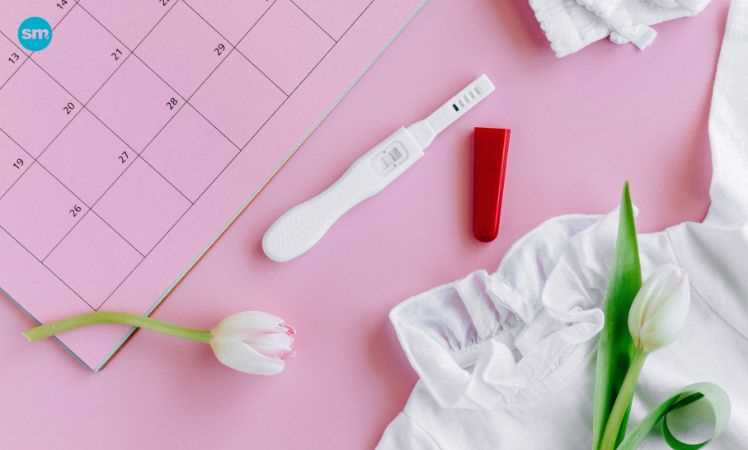Last Updated on August 21, 2023 by Lori Pace
Have you ever wondered when in your monthly cycle you’re most likely to conceive? Hint: it’s all about timing your ovulation. Ovulation is a critical part of the menstrual cycle when an egg is released from the ovaries, presenting the best opportunity for fertilization and pregnancy.
Figuring out exactly when you’re ovulating can be a bit of a science, with several different methods available to assist in tracking this vital window. In fact, there are 9 methods.
Why It’s Important to Figure Out When You’re Ovulating
Understanding when you’re ovulating is crucial, especially if you’re trying to conceive. Ovulation marks the time in your menstrual cycle when an egg is released and ready for fertilization, making it the most fertile period. By pinpointing this window of time, you can substantially increase your chances of conception by timing intercourse or insemination appropriately.
Understanding your ovulation patterns can help identify fertility issues early on and facilitate informed discussions with healthcare providers about reproductive health. Whether for family planning or monitoring health, figuring out when you’re ovulating can be empowering.
9 Different Methods to Track Your Ovulation Period
There’s more than one way to track your ovulation period, giving you plenty of options to plan ahead. Here are nine different methods to figure out when you’re potentially ovulating.
1. Traditional Calendar Method
The traditional calendar method is one of the simplest ways to predict ovulation, but it requires regular tracking and consistent cycles. To apply this method, you mark the day when your period begins on a calendar. Then, count 14 days forward (half the average menstrual cycle).
However, please note that this method isn’t error-free, as fluctuations can happen in typical menstrual cycles and affect the timeline. If you have a regular cycle length beyond or below 28 days, consider adjusting your calculations accordingly to ensure this method works wonders.
2. Ovulation App Tracker Method
In today’s digital age, the ovulation app tracker method offers an easy and convenient way to predict ovulation. With apps like Flo, the monthly cycle, and the ovulation tracker, you can keep a comprehensive log of your menstrual and ovulation cycles on your smartphone or tablet.
These applications use algorithms to predict when you’re likely to ovulate based on the data you input each month about your cycle’s length and symptoms. While more accurate than the calendar method, they still make general estimations based on averages and available data.
3. Basal Body Temperature Method
The basal body temperature (BBT) method is a more scientific approach to understanding your ovulation cycle. It involves tracking the slight temperature increase in your body that occurs after ovulation due to hormonal changes. This is typically lower before ovulation (between 96-98° F).
To employ this strategy, measure your body temperature every morning before getting out of bed. Over time, you’ll notice a pattern: a small but consistent rise in temperature indicates that ovulation has likely taken place. This presents the perfect time for intercourse or insemination.
4. Cervical Mucus Method
The cervical mucus method involves monitoring changes in cervical mucus throughout your menstrual cycle to predict ovulation. Typically, cervical mucus shifts from being dry and sticky at the start of your cycle to becoming clear and stretchy or the consistency of raw egg whites near ovulation. Discharge may appear wet/creamy and/or cloudy as estrogen levels start to rise.
This change is driven by hormonal fluctuations as your body prepares for potential conception. By closely observing these shifts on a daily basis, you can identify patterns that signal when you’re about to ovulate. However, this method requires familiarity with normal mucus variations.
5. Cervical Position Method
The cervical position method is another technique focused on physical changes in your body throughout the menstrual cycle. Specifically, it involves observing alterations in the position and feel of your cervix, which can indicate impending ovulation as well as whether you’re pregnant.
In general, your cervix might feel firm and low in your vagina during the beginning of your cycle. However, as ovulation approaches, it usually becomes softer, higher, and more open. To use this method effectively, you should check your cervical position regularly (using clean fingers!).
6. The Symptothermal Method
The symptothermal method is a comprehensive approach that combines several techniques to identify ovulation. It involves charting your basal body temperature, monitoring changes in cervical mucus, and acknowledging physical symptoms associated with ovulation.
For example, these symptoms could include bloating, mild pelvic pain, or tenderness in your breasts. When you combine these factors, it creates a more holistic picture of your fertility status and allows you to make more accurate predictions about the days when you’re most fertile.
7. Ovulation Predictor Kits
If you prefer a more scientific approach, ovulation predictor kits (OPKs) can be an excellent tool for predicting your cycle. These kits function much like pregnancy tests but are designed to detect the surge in luteinizing hormone (LH) that typically occurs right before ovulation.
When the test identifies this LH surge in your urine, it’s a clear sign that ovulation is imminent, usually within 24 to 36 hours. OPKs allow you to accurately time intercourse or insemination for optimal conception chances. They’re widely available over the counter and are easy to use.
8. Saliva Ferning Tests
The saliva ferning test is a unique method to detect ovulation that involves examining your saliva under a microscope. Around the time of ovulation, increased estrogen levels can cause your saliva to exhibit a distinct ‘fern-like’ pattern when it dries. It’s a really cool phenomenon!
By observing this pattern, you can anticipate ovulation. This method requires the purchase of a specialized optical device and some practice to discern the ferning patterns accurately. But once you’re familiar with what to look for, these tests can be an effective and non-invasive tool.
9. Have Intercourse Regularly
While this method doesn’t track your ovulation cycle, it does make it easier for you to conceive. After all, tracking ovulation isn’t necessary if you have intercourse every two days. Since ovulation lasts 24 to 48 hours, there’s a good chance you’ll have intercourse when ovulating.
With that said, this method is best paired with ovulation tracking. Once you figure out your fertile window, having intercourse every 1 to 2 days can increase your chances of conception.
There are other ways to improve your odds even further. For example, you could participate in conception intercourse and certain sexual positions that help create the perfect environment for conceiving a child. Tracking ovulation is only truly necessary if there are scheduling challenges.
In Conclusion…
There’s a wealth of knowledge available when it comes to understanding your fertility cycle. It’s all about choosing what suits you the most and being consistent with it. Whether you’re trying to conceive or simply want to comprehend your body, tracking your ovulation can be beneficial.


